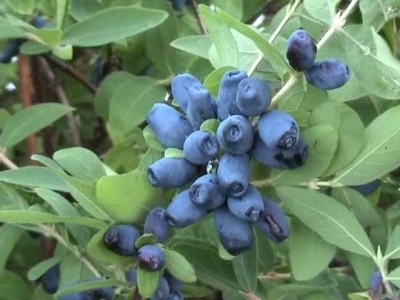
- Authors: IN AND. Putyatin, V.S. Ilin, N.A. Ilyina (Ural Federal Agrarian Research Center of the Ural Branch of the Russian Academy of Sciences)
- Year of approval: 1999
- Growth type: vigorous
- Description of the bush: slightly spreading
- Bush height, m: 2
- Escapes: medium, curved, hairless, matte, pink
- Leaves: large, dark green, pubescent, matte, leathery, concave
- Crown: spherical, with a hanging top
- Flowers: medium, pale-colored
- Fruit size: small
When planning fruit and berry plantations on the site, it is imperative to allocate a place for growing edible honeysuckle. Non-capricious and very tasty varieties include a variety of Fianit of domestic selection, capable of growing in any climatic zone.
Breeding history
Cubic zirconia is a tasty and healthy honeysuckle obtained at the South Ural Research Institute of Horticulture and Potato Growing in 1995. The authorship belongs to a group of scientists - V. I. Putyatin, N. A. Ilyina and V. S. Ilin. The variety appeared as a result of free pollination of the Smolinskaya variety.
Description of the variety
Honeysuckle Cubic zirconia is a vigorous plant endowed with a neat spherical crown, slightly spreading branches and a moderate thickening of dark green foliage. A powerful shrub characterized by curved shoots of a pinkish shade with a pronounced dullness and a developed root system. An adult shrub grows up to 2 meters in height.
The bush begins to bloom in the first week of May. The crown of the shrub is abundantly covered with large light yellow or creamy flowers, pleasantly smelling.
Fruit characteristics
Cubic zirconia is a small-fruited variety. A healthy shrub grows berries weighing 0.8-1 grams, up to 1.6 cm long, hanging on shortened stalks. The shape of the fruit is elongated or oval-elongated with a smooth surface, without visible tubercles. Ripe berries are evenly covered with a bright blue color, which is diluted with a dense bluish bloom. The peel of the berries is thin, without pubescence.
Berries have a universal purpose - they are eaten fresh, and also processed into preserves, jams, compotes, and frozen. In addition, berries are widely used in folk medicine. Due to the fact that honeysuckle berries are tender and fragile, they do not tolerate transportation well, and also cannot be stored for a long time (several days in the refrigerator).
Taste qualities
Mid-late honeysuckle tastes great. The pulp is characterized by a fleshy, tender, fibrous and moderately juicy texture. The fruit has a harmonious taste - sweet and sour, without astringency, bitterness. The aroma is of medium brightness, but quite refreshing. The pulp contains 7% sugars and less than 3% acids, as well as beta-carotene, vitamins A and C.
Ripening and fruiting
Cubic zirconia is a mid-late grade. Productivity begins in the 3rd year after planting. The berries are spiced together. You can evaluate the taste of the first berries in mid-July. The period of active maturation of honeysuckle begins in late July - early August (depending on the region of growth). Ripe fruits do not crumble, but they must be removed carefully, otherwise the separation from the stalk will not be dry.
Yield
This variety is medium-yielding. Fulfilling all the rules of agricultural technology, from one adult bush, you can collect from 1.1 to 1.7 kg of useful berries.Farmers who grow crops on an industrial scale can count on an average of 32 centners per hectare of plantations.

Self-fertility and the need for pollinators
Cubic zirconia, like other types of honeysuckle, is self-fertile. For good berry productivity, it is necessary to grow pollinating varieties with similar flowering times nearby. The optimal donor bush for Cubic Zirconia is Amphora honeysuckle. The distance between bushes should be 1.5-2 meters.
Growing and care
Planting honeysuckle is recommended in the fall: late September - early October. It is better to purchase a seedling for 2-3 years, since they have the highest survival rate.
Cubic zirconia is not capricious in its care, but it requires compliance with standard care procedures - regular watering, application of fertilizing, especially organic fertilizing, crown formation, removal of dry and damaged branches, prevention of diseases, protection from cold, as well as fluffing, weeding and mulching of the soil.
Watering is carried out in a ditch made around the bush, not at the root. Fertilizers are applied from 3-4 years of planting a bush. In the 15th year of life, rejuvenating pruning is carried out, removing old shoots at the very root.


Disease and pest resistance
The plant's resistance to disease and insect infestation is average. Most often, the Zirconia variety is exposed to the leaf mosaic virus and brown spot. Insect pests that attack the crop are the honeysuckle fingerfly, false scutellum, spider mites and aphids, which can be eliminated by spraying with insecticides.

Winter hardiness and the need for shelter
Honeysuckle has excellent frost resistance, surviving temperature drops to –30… 34 degrees. The bush does not need shelter, but deep mulching of the near-root zone will be needed.
Location and soil requirements
A berry culture can grow anywhere, but to get a good harvest, you will need a clean, bright, sunny area protected from wind and draft. The soil prefers honeysuckle loose, nutritious, breathable, moisture-permeable, with neutral acidity. Loamy and sandy loam soils are considered the best.
































































